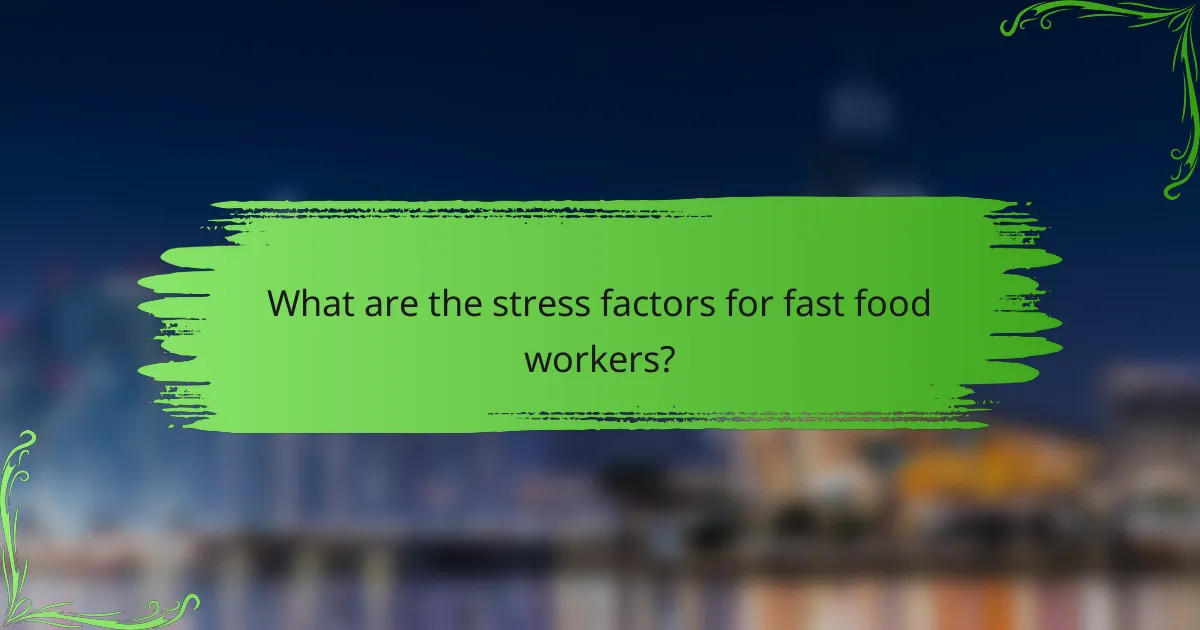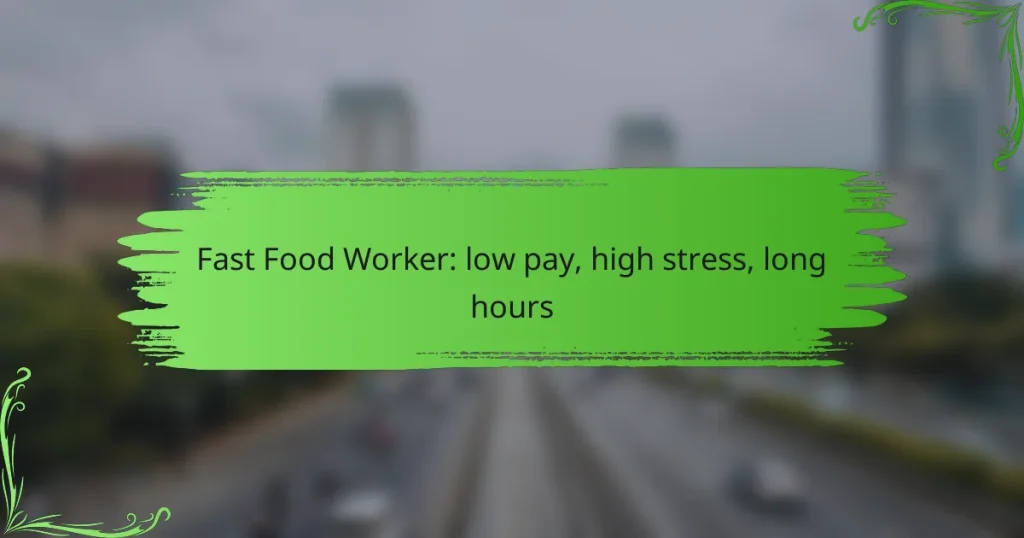Fast food workers often endure low pay, high stress, and long hours, creating a challenging work environment. The demands of the job, including dealing with high customer expectations and staffing shortages, contribute to significant stress levels. Additionally, employees frequently face extended shifts during peak meal times, further exacerbating their workload and mental strain.

How can fast food workers improve their pay?
Fast food workers can improve their pay through various strategies, including unionization, effective negotiation, and considering job changes. Each approach has its own benefits and challenges, making it essential to evaluate which option aligns best with individual circumstances.
Unionization efforts
Unionization can empower fast food workers to collectively bargain for better wages and working conditions. Joining a union often leads to higher pay rates, typically ranging from 10% to 30% more than non-unionized counterparts. Workers should research local unions, understand their rights under labor laws, and participate in organizing efforts to strengthen their position.
In many regions, unions provide resources and support for workers, including legal assistance and training on negotiation tactics. Engaging with fellow employees to gauge interest in unionizing is a crucial first step.
Negotiating tips
Effective negotiation can significantly enhance a fast food worker’s pay. Workers should prepare by researching average wages for similar positions in their area, aiming for a target salary that reflects their skills and experience. When discussing pay with management, presenting a clear case for a raise, including contributions to the team and any additional responsibilities taken on, can be persuasive.
Practicing negotiation skills and being ready to discuss specific examples of performance can bolster confidence. It’s also wise to approach negotiations at times when the business is doing well, as management may be more open to discussions about pay increases.
Job switching strategies
Switching jobs can be a viable option for fast food workers seeking better pay. Workers should assess the job market to identify opportunities at other fast food chains or related industries that offer higher wages or better benefits. Networking with former colleagues and utilizing online job boards can help uncover potential openings.
Before making a switch, it’s beneficial to compare the total compensation packages, including hourly wages, tips, and benefits like health insurance or paid time off. Transitioning to a position with a more favorable work environment or advancement opportunities can lead to long-term financial gains.

What are the stress factors for fast food workers?
Fast food workers face several stress factors that significantly impact their job performance and mental well-being. Key issues include high customer demands, challenging workplace environments, and frequent staffing shortages, all of which contribute to a high-stress atmosphere.
High customer demands
Fast food workers often encounter intense pressure to meet customer expectations quickly and efficiently. During peak hours, the volume of orders can surge, leading to a frantic pace that leaves little room for error. This constant demand can result in heightened stress levels, as employees strive to maintain service quality while managing time constraints.
For instance, during lunch and dinner rushes, workers may be expected to fulfill dozens of orders in a matter of minutes. This urgency can lead to mistakes, which further compounds stress as workers deal with dissatisfied customers and potential reprimands from management.
Workplace environment
The fast food workplace environment can be physically and emotionally taxing. Workers often operate in cramped spaces, facing high noise levels and extreme temperatures from cooking equipment. Such conditions can lead to fatigue and increased stress, especially during long shifts.
Additionally, the nature of the job requires constant interaction with customers, which can be challenging when dealing with difficult or rude patrons. This ongoing social pressure can take a toll on mental health, contributing to feelings of burnout and anxiety.
Staffing shortages
Staffing shortages are a common issue in the fast food industry, exacerbating stress for existing employees. When there are not enough workers on shift, the burden falls on those present, leading to longer hours and increased workloads. This situation can create a cycle of stress and dissatisfaction among staff.
Moreover, frequent turnover rates mean that new employees often require training, which can divert attention from regular duties and add to the existing workload. As a result, the remaining staff may feel overwhelmed, leading to decreased morale and productivity.

What are the typical working hours for fast food employees?
Fast food employees typically work a variety of hours that can range from part-time shifts to full-time schedules. Most shifts are scheduled during peak meal times, which can lead to long hours and high stress, especially during busy periods.
Shift patterns
Shift patterns for fast food workers often include early morning, afternoon, and evening slots. Many employees work part-time, with shifts usually lasting between 4 to 8 hours. Full-time employees may work 30 to 40 hours per week, often including weekends and holidays.
Some establishments offer flexible scheduling, allowing workers to choose shifts that fit their availability, while others may have fixed schedules that require employees to adhere to specific times.
Overtime expectations
Overtime is common in the fast food industry, particularly during busy seasons or special promotions. Employees may be asked to work beyond their scheduled hours, often without prior notice. Overtime pay is typically calculated at a higher rate, usually 1.5 times the regular hourly wage, in accordance with labor laws.
Workers should be aware of their rights regarding overtime and ensure they are compensated fairly for extra hours worked. Keeping track of hours can help in addressing any discrepancies with management.
Peak hours
Peak hours in fast food establishments generally coincide with meal times, such as lunch (11 AM to 2 PM) and dinner (5 PM to 8 PM). These periods often see a significant increase in customer volume, leading to heightened stress for employees.
During peak hours, workers may be required to handle multiple tasks simultaneously, including taking orders, preparing food, and managing customer service. Understanding these peak times can help employees prepare for the demands of their shifts and manage their stress levels effectively.

How does fast food pay compare to other industries?
Fast food pay is generally lower than many other sectors, often hovering around minimum wage levels. While some positions may offer slightly higher pay, the overall compensation tends to be less competitive compared to jobs in retail, hospitality, and skilled trades.
Minimum wage analysis
In the United States, many fast food workers earn the federal minimum wage, which is currently $7.25 per hour, though some states and cities have set higher minimums. Fast food employees often see little increase in pay over time, making it challenging to achieve financial stability.
For instance, in states with higher living costs, such as California or New York, the minimum wage can reach $15 or more per hour, yet even this may not be sufficient to cover basic living expenses.
Industry pay scales
Fast food pay scales typically range from minimum wage to around $15 per hour for entry-level positions. Shift supervisors or team leaders may earn slightly more, often between $15 and $20 per hour, depending on the location and company policies.
In contrast, workers in industries like technology or healthcare can earn significantly higher salaries, often starting in the low to mid-twenties per hour, highlighting the disparity in compensation across sectors.
Regional pay differences
Regional pay differences in the fast food industry can be substantial. For example, fast food workers in urban areas often earn more than those in rural regions due to higher living costs and local minimum wage laws.
In cities like Seattle or San Francisco, fast food employees may earn upwards of $16 to $20 per hour, while in smaller towns, wages might remain closer to the federal minimum. This variation underscores the importance of considering local economic conditions when evaluating pay in the fast food sector.

What are the health impacts of working in fast food?
Working in fast food can lead to various health impacts, primarily due to low pay, high stress, and long hours. Employees often face physical and mental health challenges that can affect their overall well-being and career longevity.
Physical health risks
Fast food workers frequently endure long hours on their feet, which can lead to musculoskeletal issues such as back pain and joint problems. The fast-paced environment often results in inadequate breaks, increasing the risk of fatigue and related injuries.
Additionally, exposure to hot cooking equipment and hazardous materials can pose safety risks. Proper training and adherence to safety regulations are essential to minimize these physical health risks.
Mental health considerations
The high-stress nature of fast food work can significantly impact mental health. Employees often deal with demanding customers and tight deadlines, leading to anxiety and burnout. The combination of low wages and job insecurity can exacerbate these feelings.
Support systems, such as employee assistance programs, can help mitigate these mental health challenges. Encouraging open communication about stressors in the workplace is also vital for fostering a healthier work environment.
Long-term career effects
Long-term exposure to the stresses of fast food work can lead to career stagnation. Many workers find it challenging to transition to higher-paying jobs due to limited skills and experience. This can perpetuate a cycle of low pay and high stress.
Investing in skill development and seeking advancement opportunities within the industry can help mitigate these effects. Workers should consider pursuing training programs or certifications that can enhance their employability and career prospects in the long run.

What are the benefits of working in fast food?
Working in fast food offers several advantages, including flexible schedules, entry-level job opportunities, and employee discounts. These benefits can make fast food positions appealing for students, part-time workers, and those seeking to enter the workforce.
Flexible schedules
Fast food jobs often provide flexible scheduling, which can be ideal for students or individuals with other commitments. Many restaurants offer shifts that accommodate varying availability, allowing employees to choose hours that fit their lifestyles.
This flexibility can help workers balance their personal and professional lives, making it easier to manage school, family, or other responsibilities. However, it’s essential to communicate your availability clearly to ensure you get the shifts you prefer.
Entry-level opportunities
Fast food positions typically require minimal experience, making them accessible for those entering the job market. These roles can serve as a stepping stone for career advancement within the food service industry or beyond.
Many fast food chains provide training programs that equip employees with essential skills, such as customer service and teamwork. This experience can be valuable when applying for future jobs, as it demonstrates reliability and a strong work ethic.
Employee discounts
Many fast food restaurants offer employee discounts on meals, which can significantly reduce food expenses. These discounts often range from 20% to 50%, depending on the establishment.
In addition to meal discounts, some chains provide benefits like free or discounted uniforms and access to special promotions. Taking advantage of these perks can enhance the overall compensation package for fast food workers.


